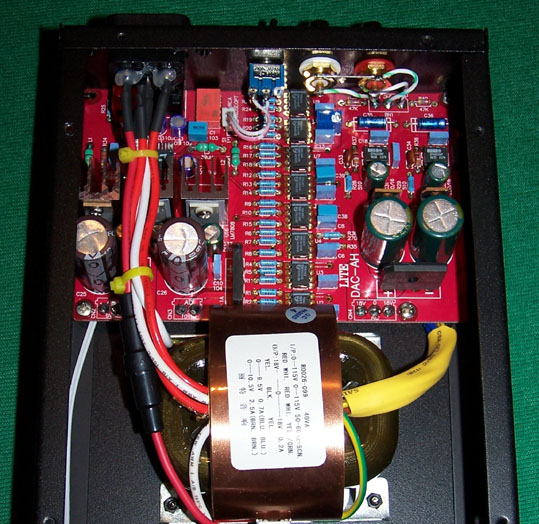Actually, I never forgot the project of Ryohei Kusunok seen on MJ magazine many years ago about a simple DAC using four Philips TD1543. Unfortunately the name "Dual 16-bit DAC (economy version)" on the datasheet of this device destroyed any possibility on the market to became one of the candidates for the best DAC chip.
Comparing the characteritics of the TDA1543 with the last Burr-Brown, Crystal or Asahi-kasei the TDA1543 has a lower Signal-to-Noise Ratio (S/N) and a higher distortion (THD) even if are remarkable for a 16 bit chip.
| Feature |
Philips |
Burr-Brown |
Crystal |
Asahi-kasei |
| DAC chip |
TDA1543 |
PCM1704 |
CS4398 |
AK4396 |
| Resolution |
16 bit | 24 bit |
24 bit |
24 bit |
| THD @ 0dB & 24 bit [%] |
|
0.003 |
0.0047 |
0.0078 |
| THD @ 0dB & 16 bit [%] |
0.018 | |
0.009 |
|
| Dynamic range 24 bit |
|
110 dB |
120 dB |
120 dB |
| Dynamic range 16 bit | |
|
97 dB |
|
| DAC S/N | 96 dB | 120 dB |
120 dB |
120 db |
There are many papers available on Internet about this DAC and the sonic result is always very good, so when I have seen on http://eshop.diyclub.biz the complete DAC-AH at the incredible price of 135$ I decided to test it.

The DAC-AH special DIYCLUB version (Red PCB) use the CS8414 as digital input reciver, 8 pcs of TDA1543 in parallel (matched). OPA602 as output stage and three seperate rectifier and regulators.
Using many TDA1543 in parallel the convertion error are reduced giving a better sound.
In the article published on http://www.dddac.de/ma_dac21.htm to author show the distortion spectrum of one dac chip and the parallel of 3 and as result the distortion value is reduced by 3 db.
My first impression is that it sounds very natural also if some details are lost if compared with my other DAC projects using DAC chips with higher resolution.
But an improvement in sonic performances can be easly achived skipping the output output stage, in fact afer this little modification the details level has been much improved.
The complete schematic for this DAC can be download here and in this is very easy to understand that the output signal quality depend on the 270 ohm resistor on the DAC chip output with the function of I/V (current to voltage) converter.
This is my new test environment

where the output signal is get from the DAC chip outputs and the 270 ohm resistor has been replaced with a 250 ohm VISHAY resistor with high stability, high precision, non inductive and low temperature coefficient (cod. 201-9854 of http://www.rs-components.com/).
After the very good Auricap 3.3uF 450V used like coupled capacitors the output level is regulated by the a 10K+10k DACT stepper attenuator able to drive any final amplifier.
The my solid state headphone amplifier is used like a reference to check the sonic performances of the OPA602.
Follows a measurement set of the signal before of any output stage get by Clio system on output to the DAC chips and driving the input signal with the SPDIF output of the USB audio interface Transit by M-Audio.
Only the new version 7.0 of Cliowin software allow to use an extenal output DAC like the Transit by M-Audio.

Follows a measurement set of this DAC with the normal output stage using the operational amplifier Burr-Brown OPA602 that is wide bandwidth FET operational amplifier with an unusual combination of high-speed and accuracy.

Follows a measurement set of this DAC using like output stage my solid state headphone amplifier.


In all these measurement I see a perfect and linear distortion spectrum decay and very low distortion level.

